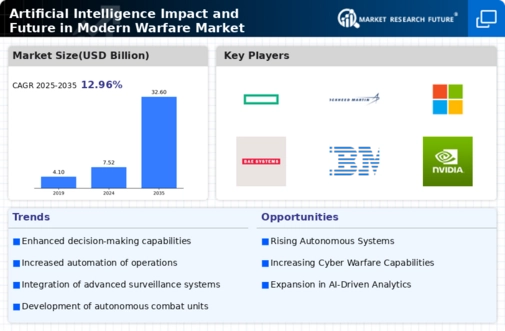Increased Focus on Ethical AI in Warfare
The increased focus on ethical AI in warfare is becoming a prominent consideration within the Artificial Intelligence Impact and Future in Modern Warfare Market. As militaries explore the integration of AI technologies, ethical implications surrounding autonomous systems and decision-making processes are gaining attention. This focus is reflected in ongoing discussions about the need for regulations and guidelines to govern the use of AI in combat scenarios. The market for ethical AI frameworks is expected to grow, with estimates suggesting a rise of around 10% annually. This growth is driven by the necessity for accountability and transparency in military operations, as well as the potential for public scrutiny. As ethical considerations become integral to AI development, the future of warfare may be shaped by a balance between technological advancement and moral responsibility.
Advancements in Cyber Warfare Capabilities
The advancements in cyber warfare capabilities, fueled by Artificial Intelligence Impact and Future in Modern Warfare Market, are reshaping the landscape of modern conflict. AI technologies enable the development of sophisticated cyber defense mechanisms that can predict and neutralize threats in real-time. The market for AI in cybersecurity is expected to reach substantial figures, with projections indicating a growth rate of approximately 20% annually. This surge is attributed to the increasing frequency of cyberattacks on military infrastructure and the necessity for robust defense strategies. As nations invest in AI-driven cyber capabilities, the potential for enhanced security and resilience against cyber threats becomes more pronounced, thereby influencing the overall dynamics of modern warfare.
Emergence of AI-Enhanced Training Simulations
The emergence of AI-enhanced training simulations represents a pivotal development within the Artificial Intelligence Impact and Future in Modern Warfare Market. These simulations utilize advanced algorithms to create realistic training environments, allowing military personnel to engage in complex scenarios without the risks associated with live exercises. The market for military training simulations is anticipated to expand, with estimates suggesting a growth trajectory of around 12% per year. This growth is driven by the increasing demand for effective training solutions that can adapt to various combat situations. By incorporating AI, training programs can be tailored to individual needs, thereby improving readiness and operational effectiveness in real-world missions.
Development of AI-Driven Intelligence Gathering
The development of AI-driven intelligence gathering systems is a critical factor influencing the Artificial Intelligence Impact and Future in Modern Warfare Market. These systems leverage machine learning algorithms to analyze vast amounts of data from diverse sources, enhancing the accuracy and speed of intelligence assessments. The market for AI in intelligence operations is projected to witness significant growth, with forecasts indicating an increase of approximately 18% annually. This growth is largely due to the rising complexity of global threats and the need for timely and actionable intelligence. As militaries adopt AI technologies for intelligence gathering, the ability to anticipate and counter threats is likely to improve, thereby shaping strategic military operations.
Integration of AI in Command and Control Systems
The integration of Artificial Intelligence Impact and Future in Modern Warfare Market into command and control systems is transforming military operations. AI enhances decision-making processes by providing real-time data analysis and predictive insights. This integration allows military leaders to respond swiftly to dynamic battlefield conditions. According to recent assessments, the market for AI-driven command and control systems is projected to grow significantly, with estimates suggesting a compound annual growth rate of over 15% in the coming years. This growth is driven by the increasing need for efficient resource allocation and improved situational awareness. As militaries worldwide adopt AI technologies, the effectiveness of command structures is likely to improve, leading to more strategic and informed military actions.


















Leave a Comment